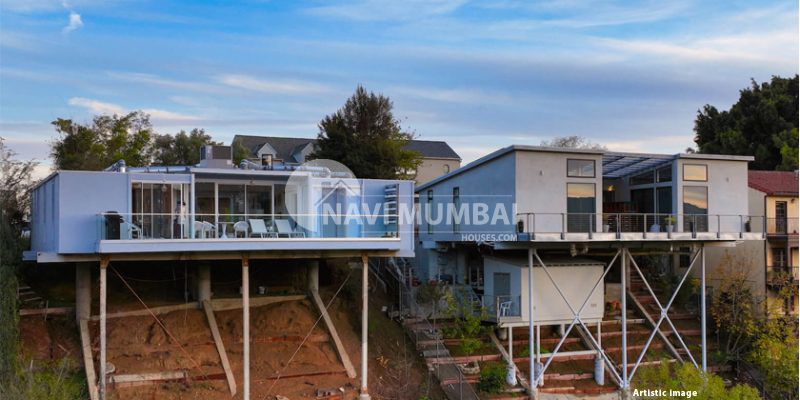
- December 17, 2022
- News
How Are Stilt Houses Made In India? What Are They?
In India, homes constructed on stilts are those constructed on land subject to flooding. Houses are often constructed based on the topography and location. There are many different types of homes, including bungalows, cottages, apartments, and condos.
Are you looking for 2bhk flats for rent in kharghar?
Among the various house types, several stilt houses are located in landscapes that are particularly prone to floods. A few people may have seen images of stilt houses, but the majority of people in towns and cities have never heard of the concept. In this article, we’ll go into more detail about a specific stilt house, including where to look for them and how they’re built.
What do you mean by a stilt house?
In India, stilt homes are typically constructed in places that frequently experience heavy rain and flooding. In comparison to a typical house, the stilt houses are placed on sturdy stilts and are situated significantly higher. Regular homes are constructed on level ground, while stilt homes are constructed on tall stilts or in a slightly elevated area to prevent the possibility of flooding, water logging, or even pest infestation.
The stilt buildings are typically located in coastal settings, but because of how vulnerable they are to flooding, residences built along rivers can also greatly benefit from their height.

What stilt dwellings are constructed above the ground?
In India, stilt houses come in a variety of styles and are constructed around the country for a variety of applications. When it comes to the Arctic, stilt homes are useful for shielding inhabitants from permafrost. In the state of Assam, inhabitants construct distinctive stilt homes along the banks of the River Brahmaputra since these places are frequently prone to flooding, particularly during the rainy seasons.
As a result, if dwellings are constructed above ground level, the heat they emit will likely cause many frosts to melt.
What components go into making a sturdy stilt house?
Stone, wood, cement, bamboo, and other materials are employed in the construction of good, long-lasting stilt homes. In some areas, even mud is needed to construct a stilt house. The stilt houses are typically located in rural areas, however modern and commercial versions of these particular houses are also common.
The verandah that is extended around a traditionally constructed stilt house varies greatly, but it never completely encircles the building. Following the remodelling of the verandahs, the stilt buildings were used to build the bedrooms and progressively more living space.
To make the stilt houses adaptable & suited for the current and contemporary lifestyle, traditional stilt house designs from India are combined with contemporary architectural features.

What distinguishes bamboo-based stilt homes from others?
The stilt homes that are best suited for flood-prone areas are those made of bamboo. The many flood-prone areas of Assam are home to a large number of bamboo-stucco stilt homes.
The designs for stilt homes are typically found in Golaghat, Assam, India. In Assam, bamboo may be found in great abundance and is typically of the highest quality. These bamboos are used by the Assamese indigenous to build bamboo stilt homes.
Why are Assamese homes constructed on stilts?
In Assam, most of the locations where flooding affects the local population at least three times annually are thought to require stilt homes. As technology has advanced, people have used local & traditional knowledge to construct better, more durable bamboo stilt buildings that are ideal for that particular region.
Major benefits of well-constructed stilt homes in India
The following are the main benefits of well-constructed stilt homes in India:
- In warmer areas, having lots of ventilation is undoubtedly advantageous. Inside the stilt houses, a cool and comfortable climate is produced by both the enhanced airflow from beneath the floors and the increased breeze obtained from the small elevation.
- During the wet seasons, the dry chambers are kept underneath a stilt home. This unique area can be used by the stilt home owners to store products, do household duties, care for and keep animals, hang objects, and carry out other practical tasks.
- When you live in a stilt house, you also get privacy from other people and safety from wildlife.
- The military can keep an eye on the surrounding landscape thanks to the stilt houses, which also give locals who like hunting a visual advantage.
- In India, it is feasible to construct a stilt house on sloped or mountainous land, as well as in locations that may be subject to heavy rain and flooding.
- The residents of a stilt house are protected from flooding by its height.
In places with hills and areas that are vulnerable to flooding, stilt homes are being built above the level of the earth. Typically, wood, stone, cement, and bamboo are used to construct the stilt homes.
In India and other nations, insurance premiums for stilt homes are typically lower. However, compared to houses that are being built on the ground, flood insurance for the stilt buildings is offered by several companies at a lower insurance rate. Owning a stilt home in an area with heavy rainfall, like Assam, necessitates purchasing flood insurance.

Different Stilt House Types around the World
The following types of stilt houses are constructed throughout the world:-
| Type of Stilt house | Description |
| Kelong | It is a stilt house which is primarily built for fishing in countries like Philippines, Malaysia, Indonesia and Singapore. |
| Diaojiaolou | It is a type of stilt house in Southern China |
| Bahay Kubo | Traditional type of stilt house available in the Philippines. |
| Queenslander | Common types of stilt house available in Queensland and Southern Australia |
| Heliotrope | It is a single stilt house designed by Rolf Disch to be optimised for harnessing solar power. |
| Thai Stilt House | It is a type of style house constructed on fresh water like above lotus pond |
| Chaang Ghar | Kind of stilt house in Assam, found in |
| flood-prone areas of the Brahmaputra | |
| Papua New Guinea stilt house | Type of stilt house found in |
| Motuans, in the southern coastal area of Papua New Guinea. |
Conclusion: Stilt House
In conclusion, it can be said that the majority of India’s stilt homes are constructed in marshy or flood-prone areas. Even though they are uncommon, stilt homes are essential in regions that frequently experience flash floods.
You’re looking for Projects in Mahim we have the Best Properties In Mumbai Like Ready to Move:https://navimumbaihouses.com/properties/search/mahim/
If you want daily property update details please follow us on Facebook Page / YouTube Channel / Twitter









